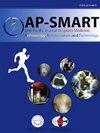患者专用器械与传统胫骨高位截骨术的比较:矫正目标的准确性及胫骨后坡改变的预防
IF 1.4
Q3 ORTHOPEDICS
Asia-Pacific Journal of Sport Medicine Arthroscopy Rehabilitation and Technology
Pub Date : 2025-09-03
DOI:10.1016/j.asmart.2025.08.006
引用次数: 0
摘要
背景:胫骨高位截骨术(HTO)对于治疗内侧室性膝骨关节炎至关重要。精确实现胫骨内侧近端角(MPTA)矫正和维持胫骨后坡(PTS)是临床成功的关键。本研究旨在比较3d打印患者专用器械(PSI)与传统HTO的使用,以实现精确的MPTA矫正和维持PTS,旨在提高HTO患者的手术效果。方法2018年9月至2021年7月104例HTO患者中,60例符合纳入标准,分为PSI组(30例)和常规方法组(30例)。放射学结果包括估计和术后MPTA值,以及术前和术后PTS测量。结果在常规HTO组中,估计的MPTA值与术后的MPTA值(94.3°±2.4°vs 93.5°±2.5°,P = 0.023)以及术前和术后的PTS值(8.8°±3.2°vs 7.9°±3.5°,P = 0.033)之间存在显著差异。相反,PSI组在这些值上没有表现出任何显著差异。结论使用psi引导下的HTO可以提高MPTA目标的准确性,提高PTS改变的预防效果。本文章由计算机程序翻译,如有差异,请以英文原文为准。
Comparison of a patient-specific instrument and conventional high tibial Osteotomy: Accuracy of correction target and prevention of posterior tibial slope change
Background
High tibial osteotomy (HTO) is crucial for managing medial compartmental knee osteoarthritis. Precision in achieving the medial proximal tibial angle (MPTA) correction and maintenance of posterior tibial slope (PTS) is essential for clinical success. This study aims to compare the use of 3D-printed patient-specific instruments (PSI) to conventional HTO to achieve precise MPTA correction and maintenance of PTS, aiming to enhance surgical outcomes in HTO patients.
Methods
Among 104 patients who underwent HTO between September 2018 and July 2021, 60 met the inclusion criteria and were categorized into a PSI group (30 cases) and conventional method group (30 cases). Radiological outcomes included estimated and postoperative MPTA values, along with preoperative and postoperative PTS measurements.
Results
Within the conventional HTO group, significant differences were noted between the estimated and postoperative MPTA values (94.3° ± 2.4° vs. 93.5° ± 2.5°, P = 0.023), as well as between the preoperative and postoperative PTS values (8.8° ± 3.2° vs. 7.9° ± 3.5°, P = 0.033). Conversely, the PSI group did not exhibit any significant differences in these values.
Conclusion
This study indicated that the use of PSI-guided HTO could provide enhanced accuracy in achieving the target MPTA and improve the prevention of PTS changes.
求助全文
通过发布文献求助,成功后即可免费获取论文全文。
去求助
来源期刊
CiteScore
3.80
自引率
0.00%
发文量
21
审稿时长
98 days
期刊介绍:
The Asia-Pacific Journal of Sports Medicine, Arthroscopy, Rehabilitation and Technology (AP-SMART) is the official peer-reviewed, open access journal of the Asia-Pacific Knee, Arthroscopy and Sports Medicine Society (APKASS) and the Japanese Orthopaedic Society of Knee, Arthroscopy and Sports Medicine (JOSKAS). It is published quarterly, in January, April, July and October, by Elsevier. The mission of AP-SMART is to inspire clinicians, practitioners, scientists and engineers to work towards a common goal to improve quality of life in the international community. The Journal publishes original research, reviews, editorials, perspectives, and letters to the Editor. Multidisciplinary research with collaboration amongst clinicians and scientists from different disciplines will be the trend in the coming decades. AP-SMART provides a platform for the exchange of new clinical and scientific information in the most precise and expeditious way to achieve timely dissemination of information and cross-fertilization of ideas.

 求助内容:
求助内容: 应助结果提醒方式:
应助结果提醒方式:


